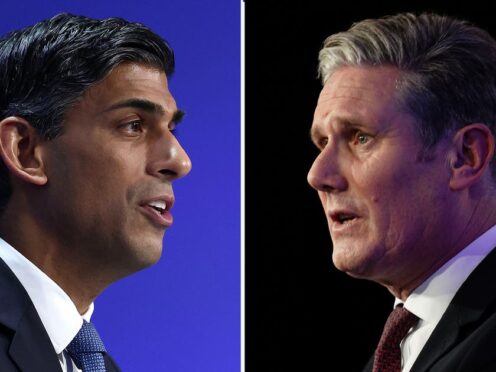Both Labour and the Conservatives are “avoiding the reality” that their plans lock them into “sharp” spending cuts after the election, a leading economic think tank has warned.
On the 13th day of the election campaign, the Institute for Fiscal Studies (IFS) said neither of the main parties appears “serious about the underlying principle of getting debt falling”.
In its assessment of campaigning, the IFS said forecasts suggest whoever is the chancellor in the autumn will be “fortunate” to meet the fiscal rule of getting debt on a downward path between 2028/29 and 2029/30, which both Labour and the Conservatives have committed to.
The think tank added that, while there are “good reasons” to want debt falling over the medium term, it described the current “fiscal mandate” as “arbitrary and gameable”.
This makes it a “poor guide to the health of the public finances”, the IFS said.
While Labour is committed to the overall debt rule, the party is proposing to change the “supplementary” fiscal target in the future to focus on the current balance of borrowing and spending, rather than overall borrowing.
The IFS said this would mean revenues would cover day-to-day spending, but would allow borrowing to invest.
It added: “There are good arguments for treating day-to-day and investment spending differently, and similar targets were in place from 1997 to 2015 under both Conservative and Labour chancellors.”

But the overall, currently binding debt rule does not make a distinction between investment and day-to-day spending, meaning Labour’s plan to borrow £23.7 billion to increase investment in supporting the transition to net zero would make it more difficult to stick within the rule.
IFS analysis shows that, under the March Budget, forecasts suggest Labour could instigate the extra borrowing without missing the debt target.
But it is not possible to conclude this will be possible at the time of a post-election autumn fiscal event, which will be accompanied by a new set of forecasts and other “moving parts”, the IFS said.
Isabel Stockton, senior research economist at IFS, described the fiscal rule as having “an unfortunate combination of characteristics”.
She added: “It is eminently gameable – and has already been gamed almost to irrelevance by the current Government; it is the loosest debt rule we have had in the past 30 years; and yet it is currently so constraining that it will either be breached, or will result in policies in practice quite different to those currently being peddled.
“It is, to be kind, not a sensible rule, and neither party appears serious about the underlying principle of getting debt falling.
“This has led to both parties avoiding the reality that they are effectively signed up to sharp spending cuts, while arguing over smaller changes to taxes and spending.”
Commenting on March forecasts suggesting Labour’s plan for net-zero investment could narrowly fall within the fiscal rule, Ms Stockton added: “If that remains the case come the autumn, then whoever is chancellor by then will be able to consider themselves fortunate. Labour, or anyone serious about government, should not rely on getting lucky.”
Responding to the analysis, Chancellor Jeremy Hunt said: “It is no surprise that Labour’s multibillion-pound energy promise, a huge chunk of their £38.5 billion unfunded blackhole, will put Labour’s fiscal rules in jeopardy and inevitably lead to £2,094 in higher taxes (for working families).
“As history tells us, when Labour run out of money they come after yours. Keir Starmer and Rachel Reeves will be no exception.
“Rishi Sunak has a record of making the difficult decisions needed to strengthen the economy. We have a clear plan and will take the bold action needed to deliver a secure future to fund our public services and put more money in the pockets of hardworking people.”
Labour has been approached for comment.
Separate analysis indicates the next government could face a £12 billion spending “black hole”.
The gap in public finances may be caused by a downgrade in productivity, higher market interest rates and paying compensation to the victims of the infected blood scandal, according to the Resolution Foundation.
It found that, at 44% of GDP, government spending is at a similar level to the peak before before austerity began, but “real, per-person day-to-day” public service spending is 6% below 2009-10 levels.
James Smith, research director at the Resolution Foundation, said the “narrow” focus by the main parties on spending pledges risks distracting from the “bigger question” of how they would manage the uncertainties facing the public finances.
He added: “This question is crucial, as whoever wins the election could be confronting a fiscal hole of £12 billion, if today’s uncertainties turn into bad news after the election. And if the next government wants to avoid a fresh round of austerity, that black hole could rise to over £33 billion.”
